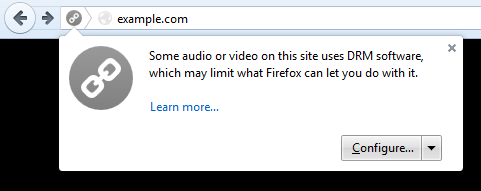Mozilla today launched Firefox 38 for Windows, Mac, Linux, and Android. Notable additions to the browser include digital rights management (DRM) tech for playing protected content in the HTML5 video tag on Windows, Ruby annotation support, and improved user interfaces on Android.
Firefox 38 for the desktop is available for download now on Firefox.com, and all existing users should be able to upgrade to it automatically. As always, the Android version is trickling out slowly on Google Play.
Mozilla doesn’t break out the exact numbers for Firefox, though the company does say “half a billion people around the world” use the browser. In other words, it’s a major platform that Web developers target — even in a world increasingly dominated by mobile apps.
Both desktop and mobile releases are getting Ruby annotation support, a long-time request from East Asian users. Ruby is essentially extra text attached to the main text for indicating the pronunciation or meaning of the corresponding characters — adding the feature to the browser means users no longer need to install add-ons like HTML Ruby.
Ruby is widely used in Japanese publications, and it is also common in Chinese books for children, educational publications, and dictionaries. Ruby support consists of four main tags: ruby (to wrap the whole ruby structure), rb (to mark the text in the normal line), rt (to mark the annotation), and rp (hidden by default, used for conversion to the inline form).
Desktop
The most important addition to Firefox 38 is undoubtedly integration with the Adobe Content Decryption Module (CDM) to play back DRM-wrapped content on Windows Vista and later. Mozilla announced the controversial (given the closed nature of DRM) move just under a year ago.
The company’s reasoning for the decision is the same today:
We are enabling DRM in order to provide our users with the features they require in a browser and allow them to continue accessing premium video content. We don’t believe DRM is a desirable market solution, but it’s currently the only way to watch a sought-after segment of content.
The CDM in question is downloaded from Adobe shortly after you install Firefox 38 or higher, and it activates when you first interact with a site that uses Adobe CDM. Mozilla says some premium video services, including Netflix, have already started testing the solution in Firefox.
Mozilla has designed a security sandbox that sits around the CDM, adding another layer of security for code that the company does not control itself. Firefox users can also remove the CDM from their copy of the browser, and the company even offers a separate Firefox release without the CDM enabled by default, available for download from here. Last but not least, Mozilla has put together a DRM teaching kit in the hopes of educating its users about the implications and challenges surrounding the technology.
Here’s the full Firefox 38 changelog:
- New: New tab-based preferences.
- New: Ruby annotation support.
- New: Base for the next ESR release.
- Changed: autocomplete=off is no longer supported for username/password fields.
- Changed: URL parser avoids doing percent encoding when setting the Fragment part of the URL, and percent decoding when getting the Fragment in line with the URL spec.
- Changed: RegExp.prototype.source now returns “(?:)” instead of the empty string for empty regular expressions.
- Changed: Improved page load times via speculative connection warmup.
- HTML5: WebSocket now available in Web Workers.
- HTML5: BroadcastChannel API implemented.
- HTML5: Implemented srcset attribute and <picture> element for responsive images.
- HTML5: Implemented DOM3 Events KeyboardEvent.code.
- HTML5: Mac OS X: Implemented a subset of the Media Source Extensions (MSE) API to allow native HTML5 playback on YouTube.
- HTML5: Implemented Encrypted Media Extensions (EME) API to support encrypted HTML5 video/audio playback (Windows Vista or later only).
- HTML5: Automatically download Adobe Primetime Content Decryption Module (CDM) for DRM playback through EME (Windows Vista or later only).
- Developer: Optimized-out variables are now visible in Debugger UI.
- Developer: XMLHttpRequest logs in the web console are now visually labeled and can be filtered separately from regular network requests.
- Developer: WebRTC now has multistream and renegotiation support.
- Developer:
copycommand added to console. - Fixed: Various security fixes.
If you’re a Web developer, more details are available for you here: Trainspotting: Firefox 38 and Firefox 38 for developers.
Android
Firefox 38 for Android doesn’t have any major additions, but it does include numerous improvements that add up. The biggest changes are visual, including improved user interfaces in multiple areas and support for the Android Lollipop look.
Here’s the full Firefox 38 for Android changelog:
- New: Improved user interfaces: New “Welcome Screen”, Reader View controls (on tablets and phones), “Synced Tabs” panel new layout (on Tablets), “Add to Firefox” feature (from outside Firefox)
- New: Ruby annotation support.
- New: Support for the Android L theme.
- New: Send a tab to another connected device with the “Send to device” option in the “share” menu.
- New: Add a website to your Reading List with the “Add to Reading List” button in the overflow menu.
- New: Locale added: Azerbaijani (az).
- Changed: autocomplete=off is no longer supported for username/password fields.
- Changed: URL parser avoids doing percent encoding when setting the Fragment part of the URL, and percent decoding when getting the Fragment in line with the URL spec.
- Changed: RegExp.prototype.source now returns “(?:)” instead of the empty string for empty regular expressions.
- Changed: Improved page load times via speculative connection warmup.
- HTML5: WebSocket now available in Web Workers.
- HTML5: BroadcastChannel API implemented.
- HTML5: Implemented srcset attribute and <picture> element for responsive images.
- HTML5: Implemented DOM3 Events KeyboardEvent.code.
- Developer: WebRTC now has multistream and renegotiation support.
- Fixed: Various security fixes.
Mozilla typically releases new Firefox versions every six weeks, and we thus expect Firefox 39 to arrive by the end of June.




